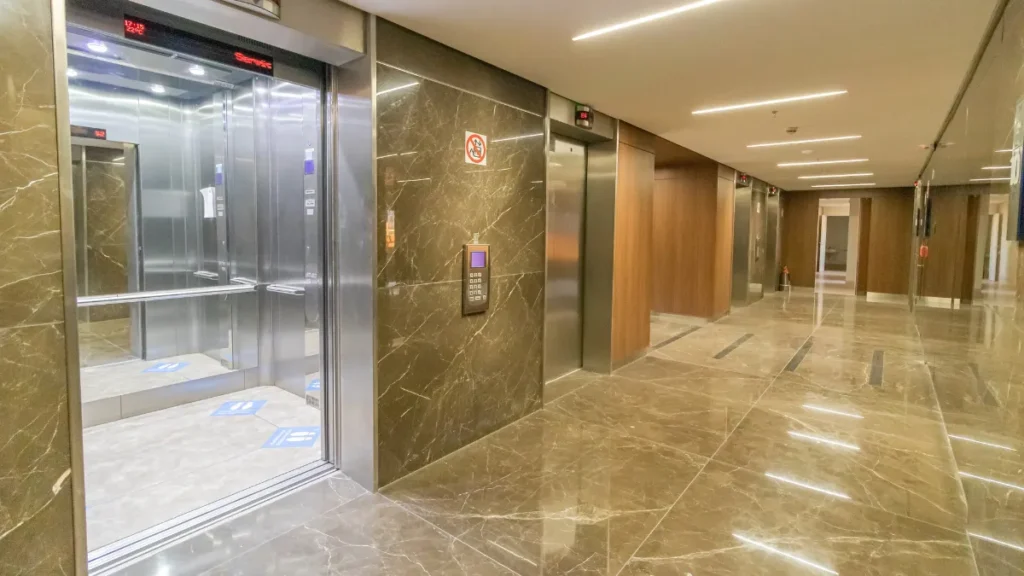Introduction
When you step into an elevator, you rarely spare a glance at the posted certificate or seal. Yet this sign shows when a lift is safe to use, making it one of the most important safety cues you can actually read. In this expert‑written guide, we explain why that sign matters, what it must include, how regulations enforce it, and how you can use it to assess elevator safety in any building.
1. Why That Safety Sign Matters
- Certifies inspection status. The sign is issued only after a certified inspector or regulatory body confirms the lift passes all safety checks including mechanical, electrical, and door systems.
- Conveys transparency. It lists inspection date, next due inspection, certifier name, a registration or permit number, and usually emergency contact info.
- Builds public trust. Passengers feel more confident using a lift that visibly displays proof of inspection and compliance.
2. What the Sign Typically Includes
Inside the cabin or near the door you’ll often find a printed label or certificate. Key elements include:
| Element | Why It Matters |
|---|---|
| Inspection date | Shows recent compliance |
| Next scheduled inspection | Confirms ongoing oversight |
| Certifying authority | Establishes credibility and accountability |
| Lift registration number | Connects to official audit trail |
| Emergency contact info | Allows reporting of problems immediately |
Some modern systems display these details digitally or via QR code, enabling users to verify status with a smartphone.
3. What the Inspection Covers
Inspectors evaluate:
- Structural integrity: cables, rails, car frame, and the shaft itself.
- Door mechanisms: auto‑reversal sensors, closing speed, manual release
- Braking systems: emergency brake activation, overspeed testing.
- Control logic: verification that software and electronics obey intended commands reliably.
Landmark accidents and evolving building designs—especially high‑speed projects—make these components critical.
4. Regulatory Framework & Standards
U.S. & International Standards
- ASME A17.1/CSA B44: Governs elevator and escalator design, construction and safety codes in the U.S. and Canada.
- OSHA 1917.116: Requires annual inspections, monthly checks, posted inspection records, and conspicuous load‑limit signage. OSHA
- ADA & IBC compliance: Facilities open to public must use tactile signs, braille, high‑contrast letters, and placed at accessible heights.
International Signage Standards
- ISO 3864 (design colours/shapes) and ISO 7010 (registered safety symbols) define signage color codes, shapes, pictograms to support universal comprehension.
- In the UK, Health and Safety (Safety Signs and Signals) Regulations 1996 permit custom symbols if they follow BS ISO principles.
These standards dictate sign colour (e.g. green for safety), font size, mounting location, and consistent details across jurisdictions.
5. Practical Tips for Passengers & Managers
For Building Managers and Operators:
- Post inspection certificates prominently, inside elevator cabin near controls or at the entrance.
- Ensure ADA‑compliant signage: tactile and braille labels at standard heights (48 to 60 inches above the floor).
- Schedule regular inspection cycles: monthly functionality checks and yearly full audits. Keep records visible or readily accessible.
- Maintain signage condition: replace faded or damaged labels to preserve clarity.
- Upgrade to digital options: QR codes or screens that provide real‑time validation.
For Elevator Users:
- Look for the sign! Check inspection date and next due date before stepping in.
- Avoid using a lift without it. If absent or outdated, ask building management or avoid using until resolved.
- Take note of warning labels. Signs about capacity, hazard warnings, or “out of service” notices signal safety issues.
- Report issues promptly. Strange noises, jerking rides, poor lighting or ventilation are signals maintenance is required.
6. Comparison Chart: Types of Lift Safety Signs
This chart shows common formats and features:
| Sign Format | Location | Typical Content | Advantages | Limitations |
|---|---|---|---|---|
| Printed certificate | Inside cabin/doorframe | Inspection date, next date, certifier info | Easy to read, low‑cost, widely recognized | Can fade, be missing or outdated |
| Metal/plastic plate | Lobby or shaft wall | Safety hazards, capacity limits, regulatory label | Durable, weather‑resistant, legible long‑term | May lack inspection date or specifics |
| Digital display / QR code | Near controls or lobby | Live inspection status, digital expiry, certifier link | Instant verification, flexible updates | Needs power and tech access |
| ADA tactile labels | Inside and outside edges | Floor number, braille, direction symbols | Inclusive, legally required, aids all users | Doesn’t show inspection status |
This guide helps building owners and users recognize the best type for reliability and compliance.
5 FAQs Before Conclusion
1. What exactly does this sign show when a lift is safe to use?
It signals that a certified inspector has verified the lift meets current safety standards. It typically displays inspection date, next due inspection, certifier name/agency, lift registration number, and relevant contact info.
2. Where should I expect to find the safety sign?
Look inside the cabin (control panel or mirror area) or near the doors in the lobby. In modern buildings, it may appear on a digital screen or via QR code.
3. How often do elevators legally need to be inspected?
In many jurisdictions like the U.S., OSHA mandates at least one full inspection annually plus monthly operational checks.
4. Can the sign look different in other countries?
Yes. While formats vary, all must comply with local building codes and often follow ISO standards like ISO 3864/7010 for color and symbols.
5. I didn’t see a sign—should I still use the lift?
No. Absence or outdated sign may mean inspection is overdue. Avoid use and report it to building management immediately.
Conclusion
This sign shows when a lift is safe to use — and while it may go unnoticed, it offers a vital confirmation of safety through inspection and compliance. For building operators, displaying up‑to‑date, ADA‑compliant signage and adhering to inspection schedules is non‑negotiable. For passengers, checking that sign empowers you to make informed, safer choices.
Elevator safety isn’t just mechanical—it’s communicated. That simple label or digital display stands between you and unseen risk. So before you press the button, take a moment: glance at the sign, read the details, and ensure it’s current. That few seconds of attention can make all the difference.
Stay informed. Stay safe.






